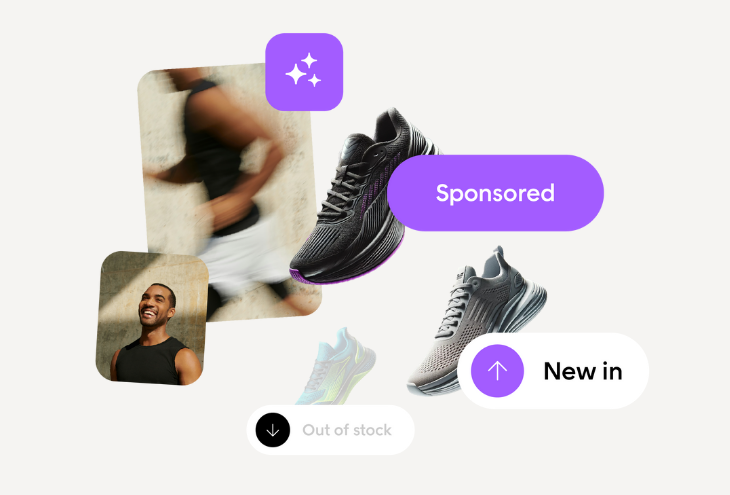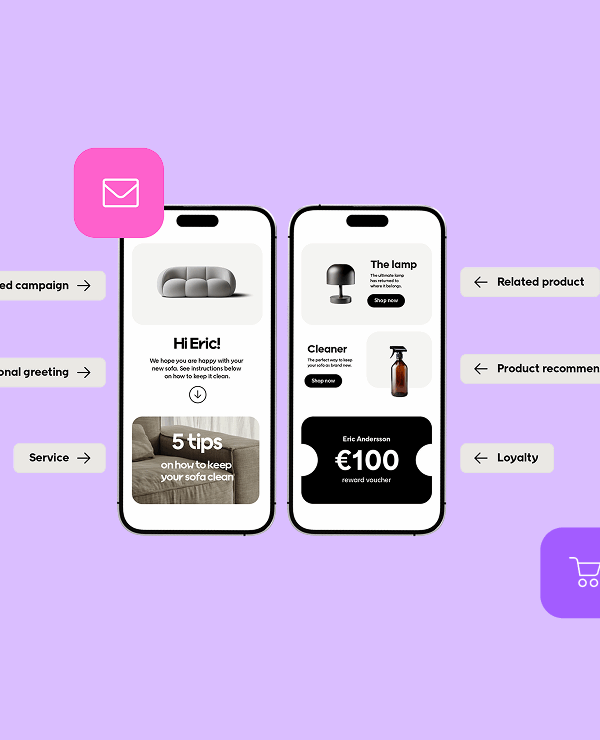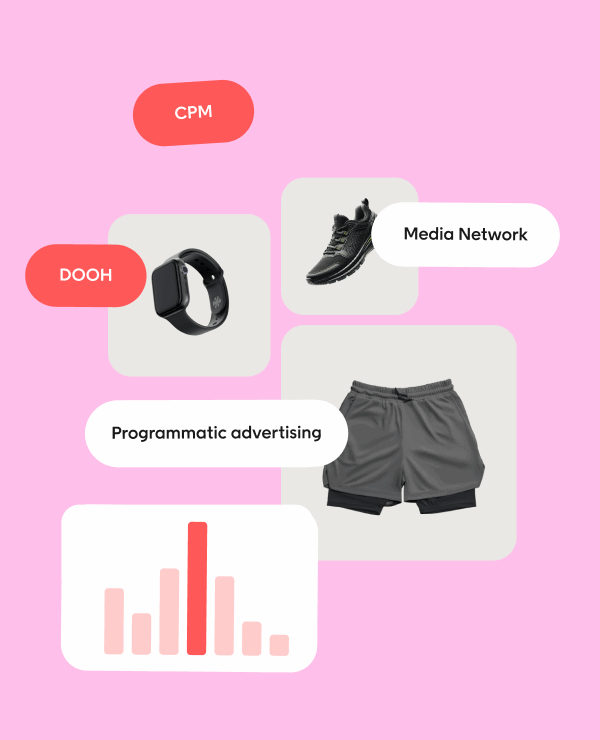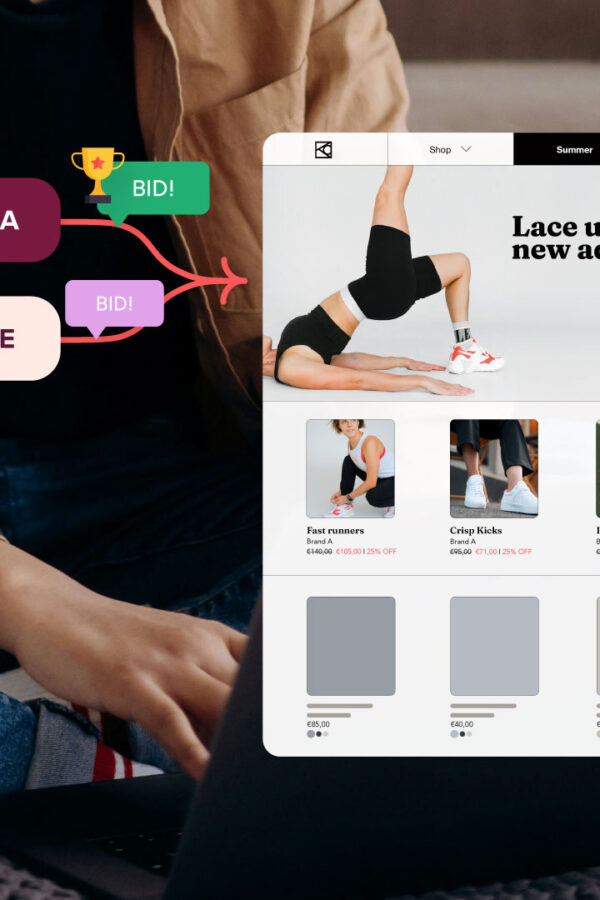Retail media is evolving fast. With global digital ad spend on retail media networks projected to surpass $168 billion by 2027, brands and retailers alike are unlocking the value of first-party data to reach relevant audiences in more impactful ways.
But while the opportunity is massive, many retailers still lack a clear strategy for activating their data, scaling their media offerings, and monetizing campaigns across in-store assets, digital platforms, and third-party channels.
We’ll break down what it takes to build and optimize a retail media program from the ground up.
Here’s what you’ll learn:
- What retail media advertising is and how it compares to commerce media
- Why retail media matters more than ever in 2025, especially with the decline of third-party cookies
- A practical, step-by-step framework to launch your retail media strategy, from auditing customer data to managing omnichannel campaigns
- Real-world examples from fashion, grocery, and beauty brands that demonstrate what successful retail media campaigns can look like
Whether you’re launching your own retail media network or optimizing existing media channels, this guide gives you the tools, structure, and retail media solutions to move from idea to execution.
What is retail media?
Retail media advertising refers to ad placements across a retailer’s owned channels like websites, mobile apps, email newsletters, in-store screens, and digital signage.
These placements allow brands to reach shoppers directly at or near the point of purchase using the retailer’s customer data.
Think: sponsored products on a homepage, display ads in an app, personalized email banners, or in-store ads near the shelf.
These are all part of a retail media platform designed to deliver relevant messages that influence buying decisions in real time.
Because retail media campaigns are powered by first-party data like purchase history, loyalty status, and on-site behavior, they enable personalized advertising that feels helpful, not disruptive.
It’s not just about placing ads; it’s about creating meaningful touchpoints that engage shoppers when they’re most likely to act.
Common retail media ad formats include:
- Sponsored search ads that boost product visibility
- On-site display on category and product pages
- In-store retail media, including digital screens and signage
- Email modules personalized with promoted listings
Some retailers are also extending campaigns beyond their own platforms by activating retail media ads across the open web and third-party platforms.
So, how is this different from commerce media?
Commerce media is the broader category that includes all advertising tied to shopping and transaction data. It covers things like affiliate links, marketplace ads, and social media platforms with buying integrations.
Retail media sits within this space but is focused specifically on the retailer’s own media channels.
Why it matters:
- Retailers unlock new revenue streams by monetizing their media inventory
- Brands get direct access to highly targeted audiences in trusted, brand-safe environments
- Shoppers receive more relevant, personalized product recommendations often right when they’re about to buy
Retail media isn’t just a trend. It’s a shift in the entire media industry and a key way for retailers to turn their customer data into a competitive advantage.
Want to dive deeper into key definitions, formats, and opportunities? Check out what you need to know about retail media.
Why retail media matters in 2025
As digital ad spend continues to shift toward retail media networks, brands are prioritizing ad placements that connect with shoppers in trusted environments.
And retailers are sitting on a goldmine of first-party data and media inventory that can be turned into measurable results.
Here’s why retail media matters more than ever in 2025:
First-party data is your competitive edge
With third-party cookies disappearing, first-party data becomes a retailer’s most valuable asset. Your CRM, loyalty programs, and purchase data hold the key to reaching relevant audiences with precision.
Retailers that offer advertising capabilities based on this data can unlock both performance and trust.
You can grow revenue without opening new stores
Retail media monetization provides a new revenue stream that doesn’t rely solely on product sales. Through onsite display, sponsored listings, or in-store ads, you can generate income by helping brands connect with your customers at key moments in the buying journey.
It enhances, not disrupts, the customer experience
Retail media ads are not just well-placed; they are well-timed. Because they appear across media channels like your app, website, or digital shelf, they serve as personalized nudges rather than noisy distractions.
When done right, they improve the shopping experience.
It delivers performance you can prove
Retail media KPIs like ROAS, AOV lift, and campaign engagement are tied to real transactions instead of vanity metrics. Unlike traditional media or generic social media networks, retail media performance is trackable, measurable, and meaningful.
That is why more brands are shifting their ad spend here and why retailers are building their own retail media programs.
3 Foundations of a great retail media strategy
Before launching any retail media program, you need a solid foundation. These three pillars will help you build a strategy that scales, delivers value to partners, and proves performance across digital and in-store advertising.
1. Business case development
Start by understanding the monetization potential already within your reach. Look at the traffic across your e-commerce site, app, and physical stores. Then consider which brands would pay to reach those shoppers and in what formats.
You need to define your retail media offerings clearly, not just offer ad placements. Will you start with sponsored search, email banners, homepage takeovers, or in-store digital signage?
Identify campaign types, estimate ad inventory value, and outline how your retail media monetization model contributes to EBIT.
When you can clearly show revenue potential, things move quickly.
2. Tech enablement
To run successful campaigns, you need the right tech stack. That includes tools for activating first-party data, segmenting audiences, automating campaign delivery, and tracking performance.
This is where Voyado comes in. With loyalty, segmentation, campaign management, and real-time data activation in one solution, Voyado supports personalized advertising across email, SMS, app, and more.
You are not just adding tools. You are enabling retail media management that actually delivers results.
3. Demand creation
Technology alone is not enough. You also need people across your organization and ecosystem who support the vision.
Start with internal alignment. Securing C-level sponsorship helps unlock resources, bring teams together, and connect marketing, CRM, and trade planning functions.
Externally, your media partners and suppliers must understand the value of advertising on your platform. Build strong relationships, educate them on the benefits, and share early results.
Start small, build momentum, and scale from there.
7 practical steps to build a retail media strategy
Retail media success doesn’t happen overnight. It starts with small, actionable steps that help you build momentum while setting the stage for long-term growth. Here’s how to move from concept to execution with confidence.
Step 1: Audit and structure your first-party data
Your first-party data is your competitive edge. Review every data source across your e-commerce site, loyalty program, app, and in-store assets. Clean and organize the data so it can be activated across digital platforms, media channels, and campaign types.
Step 2: Align C-level sponsorship
Retail media needs buy-in from the top. When executives support the strategy, it’s easier to secure resources, align teams, and prioritize media initiatives across departments.
Step 3: Map out your tech and platform needs
You don’t need a perfect stack to begin, but you do need the right foundation. Identify which tools are missing (such as a CDP, CRM, self-service platform, or analytics tools) and choose solutions that integrate well and support future scaling.
Step 4: Segment audiences based on value
Not all shoppers should be treated the same. Use your purchase data, loyalty insights, and lifecycle stages to build meaningful segments.
This helps brands target the right audience with the right message across sponsored products, banner ads, and other formats.
Step 5: Start with simple, high-impact campaigns
Begin with campaign types that are easy to launch and measure. Try sponsored search, homepage takeovers, or email banners. These formats help you show early success and get brand partners on board quickly.
Step 6: Test, optimize, repeat
Treat retail media like the performance channel it is. A/B test creatives, adjust targeting, and analyze results by segment. Optimization is an ongoing process that improves return on ad spend over time.
Step 7: Scale with demand and your partner ecosystem
Once you see traction, expand your media offerings. Add new ad formats, launch in-store advertising, and explore off-site placements through third-party channels or the open web. The stronger your ecosystem, the more valuable your retail media network becomes.
How Voyado supports retail media execution
Retail media runs on data, and Voyado is designed to help retailers turn that data into action. As a powerful retail media advertising platform, Voyado brings together the tools you need to manage campaigns, personalize outreach, and prove performance across channels.
Voyado’s product intelligence engine makes sure that sponsored product ads, sponsored search, and display ads follow the same rules as regular product listings. This means all ads are shown based on relevance, not just visibility.
They appear in the right context and match what shoppers are actually looking for. The result is a smoother shopping experience and better performance for advertisers.
CRM-native data activation
Voyado is built around real, first-party data from your customers. That includes purchase behavior, loyalty history, preferences, and engagement signals. You can use this data to create personalized advertising across digital and in-store assets.
Loyalty integration for precise targeting
Loyalty data makes your retail media program more valuable. Voyado helps you reach high-value customers with exclusive offers, re-engage lapsed buyers, and deliver tailored campaigns that drive results across your media network.
Multichannel orchestration
Your media strategy should not be limited to a single channel. With Voyado, you can coordinate campaigns across email, SMS, app notifications, push messages, and even integrate with social media platforms and other digital channels.
Built-in analytics and ROI tracking
Voyado makes it easy to measure what matters. You can track performance in real time, analyze key retail media KPIs, and connect campaign results directly to revenue. This visibility gives you the insights you need to optimize future media campaigns and scale what works.
Built for multichannel and multi-region retailers
Whether you operate across multiple markets or manage several banners, Voyado is built to support your complexity. Its intuitive setup and flexible structure make it easy to manage campaigns at scale without losing speed or control.
Key retail media KPIs to measure
Retail media is a performance-driven channel. Success depends on measuring the right outcomes. Tracking clear KPIs helps you understand what is working, improve your media offerings, and demonstrate value to internal stakeholders and brand partners.
Here are the metrics that matter most:
1. ROAS (Return on Ad Spend)
This is your primary performance indicator. ROAS tells you how much revenue each campaign generates per dollar spent. A high ROAS shows that your retail media advertising is efficient and effective.
2. Incremental revenue from sponsored media
Look beyond baseline sales and measure the additional revenue directly attributed to your retail media campaigns. This helps you isolate their true impact across different formats, including sponsored products and promoted listings.
3. Engagement by customer segment
Evaluate how different audiences respond to media campaigns. Are loyalty members clicking more often? Are new customers converting faster? Segment-level insights are critical for targeting and personalization.
4. Brand partner ROI
If your media program includes external brand sponsors, their success matters too. Track performance by brand and share campaign results such as impressions, clicks, conversions, and sales to strengthen relationships and encourage repeat ad placements.
5. AOV lift (Average Order Value)
Measure how campaigns influence basket size. A higher AOV can indicate that shoppers are responding to cross-sell recommendations, personalized offers, or premium placements on the digital shelf.
6. Repeat purchase behavior
Retail media should drive long-term value. Track whether media-exposed customers return, join your loyalty program, or make additional purchases. This shows how advertising efforts translate into retention.
These KPIs help support retail media optimization by providing a complete view of performance across ad formats, digital signage, media channels, and in-store advertising.
Retail media scenarios: What’s possible with the right tools
Retail media is not just for industry giants. With the right foundation, retailers of all sizes can activate their first-party data, attract brand partners, and deliver campaigns that drive measurable value.
The examples below are inspired by real-world challenges and use cases and show how a retail media strategy could take shape in different contexts.
Fashion retailer: Loyalty meets seasonal spotlighting
A mid-sized fashion brand wants to boost early sales ahead of a new collection drop. Using a platform like Voyado, the team segments high-value loyalty customers based on preferences and recent activity. These shoppers receive a sneak peek through personalized email and app notifications, sponsored by a key footwear brand.
The campaign combines on-site display, promoted listings, and email banners. Results include stronger click-through rates, higher basket values, and increased visibility for both the retailer and the featured partner.
Electronics retailer: Driving seasonal engagement with relevant ads
A national electronics retailer launches a seasonal campaign focused on home entertainment bundles. The team uses customer data to send targeted email offers and promote sponsored display ads from partner brands on in-store digital signage.
All ads follow the same relevance rules as standard product listings, ensuring they appear in the right context and reach the right shoppers. The result is stronger engagement, higher click-through rates, and better visibility for participating brands.
Online beauty brand: Sponsored content that builds trust
A growing online beauty brand wants to test new ways of monetizing its newsletter. The team launches a co-branded content series featuring seasonal skincare advice, sponsored by partner suppliers. Campaigns are powered by behavioral segmentation and opt-in engagement.
The result is one of the brand’s highest-performing digital campaigns, with strong open rates, meaningful click-throughs, and positive feedback from both customers and partners.
Final thoughts: Now is the time to act on retail media
You do not need a perfect setup to start with retail media. What you need is a clear goal, the right tools, and the willingness to learn as you go.
Retail media is one of the fastest-growing opportunities in digital advertising. As more ad spend moves away from third-party platforms and into retailer-owned media networks, the brands and retailers that act early will have the advantage.
Start small. Test campaigns. Use your retailer’s customer data to build a media program that fits your business. Whether you focus on on-site display, in-store assets, sponsored products, or a multichannel mix, you can create media offerings that deliver value to both shoppers and brand partners.
Voyado makes it easier to manage campaigns, activate audiences, and prove performance. Whether you are building your first program or looking to scale, you have access to all the tools you need.
Want to hear how other experts are approaching retail media? Explore real insights and conversations in our ‘Curious About Retail Media‘ series.
Book a demo to see how Voyado helps retailers turn first-party data into powerful retail media opportunities.
FAQs
What is retail media?
Retail media refers to advertising on a retailer’s owned channels, such as websites, apps, emails, and in-store displays. These ads are typically powered by first-party customer data and delivered through a retail media platform to reach shoppers at key moments in the buying journey.
What is retail media advertising?
Retail media advertising allows brands to promote their products within a retailer’s ecosystem. This includes sponsored search, display ads, digital signage, and more. These campaigns rely on the retailer’s data to reach the right audiences, often using a retail media advertising tool or platform to manage and deliver content.
How do retailers monetize their customer data?
Retailers monetize first-party data by offering brands access to ad placements that are targeted based on behavior, loyalty status, and purchase history. This approach creates a new revenue stream and supports retail media solutions for monetization without relying solely on product sales.
What tools are needed for retail media?
A strong retail media setup includes a CRM or CDP, campaign management software, automation tools, and analytics. A platform like Voyado acts as a complete retail media advertising tool that enables segmentation, personalization, and multichannel delivery.
What kind of analytics matter for retail media?
Retail media analytics help track performance across formats, audiences, and channels. Retailers use these insights to measure ROAS, AOV lift, repeat purchase behavior, and brand partner ROI. Solid analytics are essential for digital advertising as well as retail media measurement and ongoing optimization.
What is the difference between commerce media and retail media?
Commerce media is a broader category that includes ads on marketplaces, affiliate platforms, and transactional apps. Retail media focuses specifically on a retailer’s owned channels and often uses first-party data for precision targeting. Understanding commerce media vs retail media helps brands choose the right strategy for their goals.
What does a retail media network strategy involve?
Building a retail media network strategy means defining your media offerings, setting goals for monetization, aligning tech and teams, and building relationships with brand partners. It also includes selecting the right tools to manage campaigns and measure results effectively.
What are common retail media challenges?
Retailers face several challenges, including fragmented tech stacks, internal silos, limited campaign management capabilities, and lack of expertise. Overcoming these retail media challenges requires clear planning, cross-team collaboration, and scalable tools.
Can retail media work across multiple channels?
Yes. Multichannel retail media includes campaigns across email, SMS, apps, and in-store screens, while omnichannel retail media goes a step further by delivering consistent messaging across all touchpoints. A platform like Voyado supports both strategies with unified segmentation and campaign orchestration.
How can retailers get started with retail media optimization?
Start by auditing your data, setting clear goals, and launching simple campaigns. Use analytics to test and refine, then scale gradually. Ongoing retail media optimization ensures that campaigns stay relevant, efficient, and impactful for both the retailer and the brand partner.
Explore Voyado Retail Media today!









